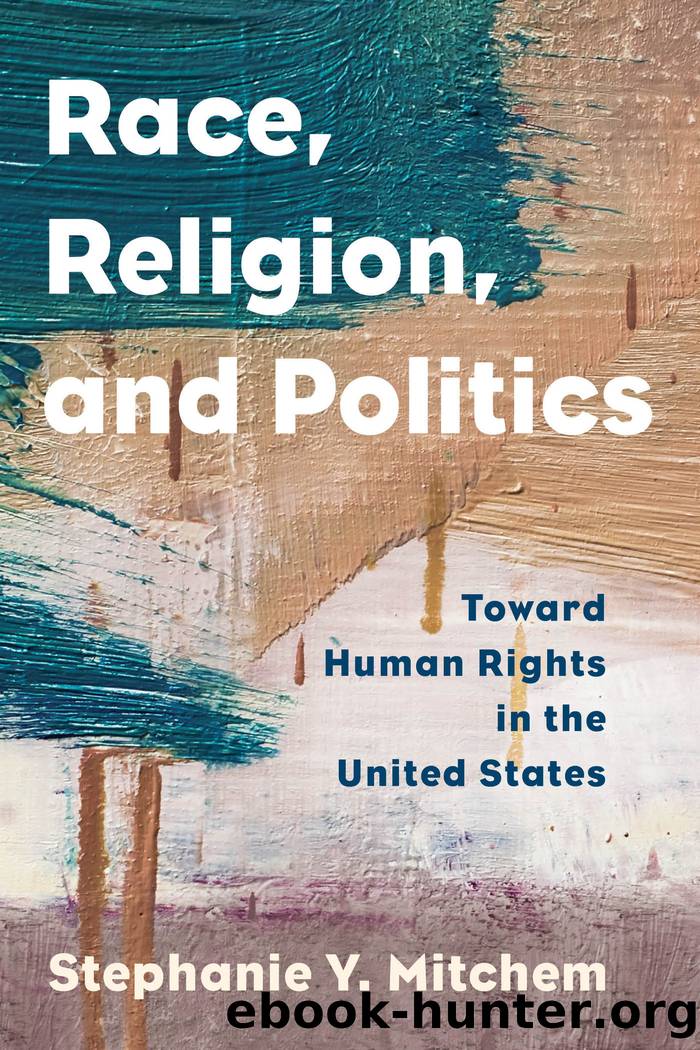Race, Religion, and Politics by Mitchem Stephanie Y

Author:Mitchem, Stephanie Y.
Language: eng
Format: epub
Tags: undefined
Publisher: Rowman & Littlefield Publishing Group, Inc.
Published: 2012-07-15T00:00:00+00:00
History and Unspoken Politics
Missing from the movies or the official term, Hispanics, are facts of the United States’ relationships with the various Latin American countries from which American Latinos/Latinas originate. There is a quote attributed to former Secretary of State Henry Kissinger that characterizes relationships with Latin America: The United States has no permanent friends or enemies, only interests. To consider the history of the areas from which U.S. Latinos/Latinas derive is to reflect on the foreign policies, the U.S. interests that have shaped the areas, the immigration patterns, and the people from those areas. This historical overview is not to present detailed histories of the twenty or so countries that make up Latin America but to give a glimpse into the complexities.
There are exciting and amazing stories to be told in the individual lands that make up Latin America in the individual histories. But the focus of race-politics-religion in the United States, in considering what is at stake, leads to thinking about what, as Kissinger said, those interests are. Rather, I am contending that there are certain themes that have determined current relationships.
The idea of the United States having a “Manifest Destiny” to stretch from the Atlantic Ocean to the Pacific Ocean drove the country’s interests in the nineteenth century. “In a period of only five decades, the territory of the United States more than tripled, and both national rhetoric and policy invited westward migration and immigration.”[15] The Louisiana Purchase in 1803 involved buying an area from France and may have whetted the desire to expand. So, through treaties or force, by 1820, Florida and the Southeast were annexed. “Texas, California, and the southwest by 1855; and finally, Central America and the Caribbean during the second half of the century, a phase that culminated with the Spanish American War of 1898.”[16]
With Native Americans, acquiring lands was the primary interest. With African Americans, the use of bodies and labor was the controlling factor. But reaching into the lands around the United States was different. Not only did the expansions remake the United States but also the surrounding regions.
Those annexations transformed an isolated yeoman’s democracy into a major world empire. In the process, Mexico lost half of its territory and three-quarters of its mineral resources, the Caribbean Basin was reduced to a permanent target for Yankee exploitation and intervention, and Latin Americans were made into a steady source of cheap labor for the first U.S. multinational corporations.[17]
Download
This site does not store any files on its server. We only index and link to content provided by other sites. Please contact the content providers to delete copyright contents if any and email us, we'll remove relevant links or contents immediately.
| African-American Studies | Asian American Studies |
| Disabled | Ethnic Studies |
| Hispanic American Studies | LGBT |
| Minority Studies | Native American Studies |
Cecilia; Or, Memoirs of an Heiress — Volume 1 by Fanny Burney(31332)
Cecilia; Or, Memoirs of an Heiress — Volume 3 by Fanny Burney(30934)
Cecilia; Or, Memoirs of an Heiress — Volume 2 by Fanny Burney(30889)
The Great Music City by Andrea Baker(21283)
We're Going to Need More Wine by Gabrielle Union(18072)
Bombshells: Glamour Girls of a Lifetime by Sullivan Steve(13108)
Pimp by Iceberg Slim(12931)
All the Missing Girls by Megan Miranda(12747)
Fifty Shades Freed by E L James(12449)
Norse Mythology by Gaiman Neil(11883)
Talking to Strangers by Malcolm Gladwell(11875)
Crazy Rich Asians by Kevin Kwan(8349)
Mindhunter: Inside the FBI's Elite Serial Crime Unit by John E. Douglas & Mark Olshaker(7833)
The Lost Art of Listening by Michael P. Nichols(6472)
Enlightenment Now: The Case for Reason, Science, Humanism, and Progress by Steven Pinker(6405)
Bad Blood by John Carreyrou(5768)
The Four Agreements by Don Miguel Ruiz(5510)
Weapons of Math Destruction by Cathy O'Neil(5036)
We Need to Talk by Celeste Headlee(4868)
